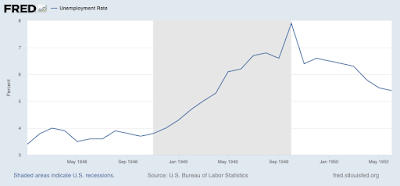Lessons for the present from the Postwar Boom One of the things I harp on from time to time is that from 1932 to 1956 there was never a yield curve inversion, and yet recessions certainly did happen! Too many modern models get hung up on Fed intervention. But what happens when the Fed doesn’t intervene, as was the case for that 25 year period? Or is perhaps the case now, with the Fed funds rate at record levels below the inflation rate? The case of the immediate postwar Boom of 1946-48 and the recession of 1949 bears a lot of similarities to our current situation – but some significant differences too. I wrote a lengthy post about it, and it is up on Seeking Alpha. A factor I didn’t even get into in that discussion was how the GI
Topics:
NewDealdemocrat considers the following as important: postwar boom, US EConomics, US/Global Economics
This could be interesting, too:
NewDealdemocrat writes JOLTS revisions from Yesterday’s Report
Bill Haskell writes The North American Automobile Industry Waits for Trump and the Gov. to Act
Bill Haskell writes Families Struggle Paying for Child Care While Working
Joel Eissenberg writes Time for Senate Dems to stand up against Trump/Musk
Lessons for the present from the Postwar Boom
One of the things I harp on from time to time is that from 1932 to 1956 there was never a yield curve inversion, and yet recessions certainly did happen! Too many modern models get hung up on Fed intervention.
But what happens when the Fed doesn’t intervene, as was the case for that 25 year period? Or is perhaps the case now, with the Fed funds rate at record levels below the inflation rate?
The case of the immediate postwar Boom of 1946-48 and the recession of 1949 bears a lot of similarities to our current situation – but some significant differences too.
I wrote a lengthy post about it, and it is up on Seeking Alpha.
A factor I didn’t even get into in that discussion was how the GI Bill and the swift integration of returning servicemen into the labor force mirror the swift increase in re-employment of those laid off during the initial period of lockdowns and closures.
For example, the modern unemployment rate statistics just started to get published in 1948, and like now, it was close to 3%:

As usual, by clicking over and reading, you should learn some important historical information, and it also puts a couple of pennies in my pocket as well.
